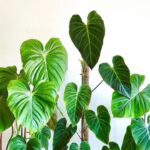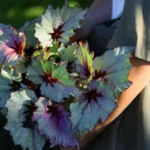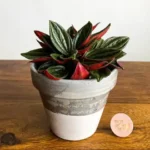Introduction to a Tropical Gem
Among the many striking houseplants appreciated by indoor gardeners, Alocasia micholitziana stands out with its dramatic foliage and elegant presence. Native to the Philippines, this species is often referred to as the “Green Velvet” or “Velvet Alocasia” for its lush, velvety leaves adorned with striking white veins. It’s one of the more exotic-looking members of the popular Alocasia genus, appealing to plant enthusiasts looking to bring a touch of the tropics indoors.
While it may not be the easiest plant to care for, Alocasia micholitziana rewards attentive growers with its unique beauty and architectural form. This article will guide you through understanding, growing, and maintaining this fascinating plant, making it approachable even for beginners eager to expand their indoor jungle.
Understanding Alocasia Micholitziana
Alocasia micholitziana belongs to the Araceae family and thrives in tropical environments. Known for its limited natural habitat in Luzon, Philippines, this plant has gained popularity worldwide due to its ornamental value. The leaves are elongated, arrow-shaped, and covered in fine, velvety texture—a trait that sets it apart from glossier Alocasia types.
It’s important to note that there are different cultivars of Alocasia micholitziana, the most common being the ‘Frydek’ variety, which is particularly sought-after for its intense coloration and smaller growth habit, making it more suitable for indoor cultivation.
Key Features of Alocasia Micholitziana
- Leaf Texture: Velvety, matte surface with raised silvery-white veins.
- Growth Habit: Upright to arching stems with leaves reaching up to 30–45 cm (12–18 inches) in length.
- Light Needs: Prefers bright, indirect light but can tolerate short periods of direct sunlight if acclimated properly.
- Humidity Requirements: Thrives in 60%+ humidity and does best in warm, humid environments.
- Toxicity: Like other Alocasias, it’s toxic to pets and humans if ingested.
Caring for Alocasia Micholitziana
Growing Alocasia micholitziana successfully indoors requires mimicking its native habitat as closely as possible. With a bit of effort, even beginners can enjoy its striking presence in their home.
Light Requirements
This tropical plant loves bright, indirect sunlight. South or east-facing windows are often ideal. If the light is too intense, the leaves can become scorched. Conversely, too little light will slow down growth and result in leggy, weaker stems.
Tips:
- Use sheer curtains to diffuse harsh midday sunlight.
- If your space lacks natural light, consider using grow lights to support healthy growth.
Watering Practices
Proper watering is key to keeping your Alocasia happy. These plants do not like to sit in soggy soil, but they don’t like to dry out completely either. A well-draining potting mix and a pot with drainage holes are essential.
Guidelines:
- Water when the top 1–2 inches of soil feels dry.
- In winter, reduce watering frequency as the plant’s growth slows down.
- Use room-temperature, filtered water whenever possible to avoid leaf tip burn from chemicals like chlorine or fluoride.
Humidity and Temperature
High humidity is crucial for Alocasia micholitziana. Without it, the leaves may develop crispy edges or show signs of stress.
Ideal Conditions:
- Maintain humidity levels above 60%, ideally around 70–80%.
- Place the plant in a bathroom or near a humidifier to maintain moisture.
- Temperature range should be between 18–27°C (65–80°F). Avoid cold drafts and sudden temperature drops.
Soil and Fertilization
A rich, well-draining soil mix is vital. Most tropical plant potting mixes or an aroid-specific mix will work well. A blend of peat, perlite, and coco coir with optional orchid bark creates an ideal growing medium.
Feeding Schedule:
- Apply a balanced liquid fertilizer diluted to half strength every 2–4 weeks during spring and summer (growing season).
- Stop fertilizing in the fall and winter unless the plant continues to put out new growth.
Repotting and Pruning
Repot your Alocasia micholitziana every 1–2 years or when it becomes root-bound to encourage healthy growth. Choose a pot that is 1–2 sizes larger to provide room for expansion.
While pruning isn’t often necessary, you can remove yellowing or damaged leaves to improve appearance. Always use clean scissors or pruning shears to prevent stem infections.
Common Pests and Problems
This Alocasia is vulnerable to several pests, including spider mites, aphids, and mealybugs. Regular inspection and prompt action are key to keeping your plant healthy.
Prevention and Treatment:
- Wipe leaves regularly with a damp cloth to keep them clean and discourage pests.
- Use insecticidal soap or neem oil as a natural treatment if infestation occurs.
- If the plant seems droopy or stops growing, reassess your light and watering practices.
Propagation Tips
Propagation of Alocasia micholitziana is typically done through division rather than cuttings. This method ensures genetic consistency and helps maintain the plant’s robust growth habits.
How to Propagate by Division:
- Wait until spring or early summer when repotting the plant.
- Carefully remove the plant from its pot and gently separate the rhizomes (underground stems) ensuring each division has at least one healthy leaf and root system.
- Replant divided sections into appropriately sized pots with fresh potting mix. Water lightly to settle the soil.
Seasonal Dormancy
Don’t panic if your Alocasia starts to drop leaves or appears dormant during the colder months. This is a natural part of its lifecycle. In low light and cooler temperatures, the plant conserves energy and may stop growing temporarily.
What You Can Do:
- Reduce watering and stop fertilizing during dormancy.
- Keep the plant in a warm spot with indirect light to prevent full die-back.
- Resume regular care once new growth appears in spring.
Conclusion
Alocasia micholitziana is a show-stopping tropical plant that can bring drama and elegance to any indoor setting. While it requires a bit more attention than your average houseplant, the results are more than worth the effort. With proper care—bright indirect light, consistent moisture, and high humidity—you can enjoy its luxurious velvet foliage year-round.
Whether you’re looking to level up your indoor plant collection or simply captivated by its bold appearance, the Green Velvet Alocasia is an investment in beauty and botanical satisfaction.
References
- Bangcaya, A., & Madulid, D. A. (2017). Flora of the Philippines: Annotated Checklist of the Alocasia Species. Philippine Journal of Science, 146(2), 133–142.
- Bowden, L. (2021). Alocasia Care Guide: Tips for Growing Stunning Foliage Plants. Houseplant Central. Retrieved from https://houseplantcentral.com/alocasia-care/
- Missouri Botanical Garden. (n.d.). Alocasia micholitziana ‘Frydek’. Retrieved from https://www.missouribotanicalgarden.org








